Content
To date, there are already a considerable number of services that offer cryptocurrency exchange services. The popularity of virtual currency is only growing, and exchange platforms are becoming more and more in demand.
Not all well-known exchanges are reliable and honest, so the niche remains open to new and improved companies.
In our new article, we will tell you how to create a crypto exchange and cover the following topics:
- The many types of cryptocurrency exchange platforms
- The main cryptocurrency exchange architecture challenges
- How to create a cryptocurrency exchange without mistakes?
- Top must-have and advanced features in crypto exchange in 2022
- What tech stack do you need to develop cryptocurrency exchange website?
- What development stages should you go through to develop a great crypto exchange?
Read Also: How To Outsource Fintech Software Development Right? [7 Quick Steps]
What is a Crypto Exchange Platform?
To understand how to create a crypto exchange, you need to start from the basics. A crypto exchange platform is an online platform where users buy, sell, and exchange cryptocurrencies. A cryptocurrency exchange works similarly to an online broker, as users can deposit fiat currency (such as US dollars) and use those funds to buy cryptocurrencies. Users can also exchange one cryptocurrency for another, and some exchanges allow users to earn interest on the cryptocurrency held in the exchange account.
Trends in Crypto Exchange Market [2024]
Before we learn how to create a crypto exchange platform, let’s look at the hot trends in the cryptocurrency world in 2022. Our team is committed to following the latest trends to create really popular but unique products.
Metaverse
It’s no secret that at the end of 2021, against the backdrop of Zuckerberg’s statements and the renaming of Facebook to META, interest in the metaverses has grown significantly.
Now, human interaction is reaching a new level as social networks, payment systems, and augmented reality applications become part of the same ecosystem.
Experts are sure that purchasing digital real estate in virtual worlds will be much more common. A striking example of a leading project in the metaverse is the Cosmos project. New blockchains in the metaverse can become part of a separate infrastructure. Decentralized exchanges, stablecoins, and DeFi are already connected to the Cosmos ecosystem.
Large companies such as Google, following Facebook, may announce the creation of their own virtual worlds.
NFTs and DeFi
Many experts are confident that NFTs, having experienced a big boom in popularity in 2021, will remain more in demand due to the development of the metaverses.
Non-fungible tokens will provide proof of ownership when purchasing virtual objects. Tokenization will continue to increase in volume – not only individual users but also entire companies are already resorting to it. From a passing infatuation, a new industry for business relationships was born. DeFi will be responsible for the convenience of economic relations in the metaverse.
The NFT and decentralized finance market will develop as it has not reached its peak. While a large percentage of the NFT segment will not be valuable developments in these areas allow the market to grow.
Development of green mining
Criticism of excessive energy consumption in bitcoin mining has become one of the reasons for the ban on mining and cryptocurrencies in China in 2021. Against this background, Elon Musk’s company Tesla also refused to accept ВТС as payment for its goods. Fortunately, BTC mining can be completely environmentally friendly.
Miners are increasingly using “green” energy to mine coins. According to some estimates, it accounts for about 58% of all . Most often, miners use the energy from hydroelectric power plants – it is cheaper than thermal power plants.
Alternative energy solutions are also developing. For example, mining farms are opened on oil wells and use the emitted petroleum gas, and the use of solar energy is also growing. In 2022, we will hear more often about the next “greening” of cryptocurrency mining. Benefits will be given to those projects that consume less energy than others.
Artificial Intelligence
Artificial intelligence is one of the critical technologies of the Fourth Industrial Revolution. As Google China President Lee Kai-Fu previously predicted, AI will become the new electricity in the next decade – it will be applied everywhere.
According to the IDC company’s research, in 2024, the total value of AI systems sold in the world will reach $98 billion (compared to $37.5 billion in 2019). The main buyers of such systems will be retail and the banking sector.
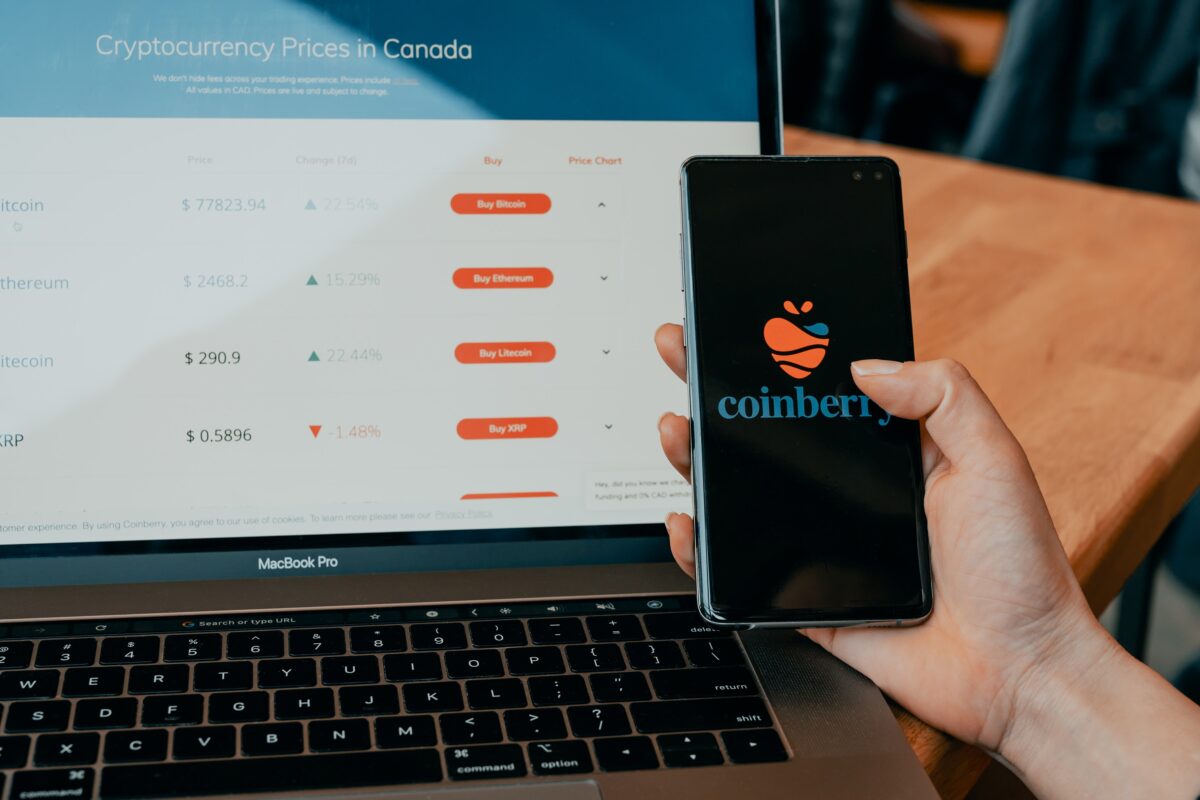

The Main Three Types of Crypto Exchange Platform
To develop, you first need to know what types of platforms exist. So let’s look at 3 main types of crypto exchange platforms:
Decentralized exchanges (DEX)
In decentralized crypto exchanges, there is no one or group of managers. The fact that no one controls the crypto exchanger indicates that the work of the exchanger is not subject to any decrees from the center. It is a decentralized platform.
All blockchain nodes that form the exchange network operate on the principle of a smart contract. The process of buying, selling, or exchanging cryptocurrency here takes place without control from the main server.
On decentralized cryptocurrency exchanges, you can also exchange not only tokens of various architectures, such as Bitcoin or the more complex Ether, but also make transactions with fiat money.
To use the service of decentralized cryptocurrency exchanges, you need to register on the exchanger and then go through the identity verification procedure.
Centralized exchanges (CEX)
Centralized cryptocurrency exchanges offer online platforms that allow you to swap cryptocurrency and traditional fiat currencies at the same time.
A centralized cryptocurrency exchange works on the same principles as a public or private bank. A client who wants to conduct an activity, such as trade Ether or Bitcoin, entrusts their funds to the cryptocurrency’s website.
Before starting work with a centralized cryptocurrency exchange, each potential user must go through a mandatory registration procedure and then a complex verification procedure.
Hybrid cryptocurrency exchanges
To solve the scalability issues inherent in decentralized exchanges, the hybrid crypto exchange allows users to store and access their private keys. Decentralized exchanges’ hefty trading costs were a major concern for the developers of the hybrid crypto exchange. There are no taker or gas costs while trading on a hybrid crypto exchange.
Read Also: How to Build a Peer-to-Peer (P2P) Marketplace Website in 2024?
Five Crypto Exchange Development Challenges
To successfully create a cryptocurrency exchange, you should know about several challenges you may face during the development process.
Let’s analyze each of the challenges:
Crypto Exchange Security
When issuing a license for crypto exchange, many jurisdictions pay special attention to ensuring that the personal data of your future users is safe. By creating a cryptocurrency exchange, your company will operate not only with money but also with the personal data of many people. As a result, you should plan ahead of time to create a cryptocurrency exchange service that is safe and secure.
When securing your future cryptocurrency exchange, keep the following things in mind:
- KYC (Know Your Customer) is a mandatory procedure for identifying counterparties for cryptocurrency exchanges. It includes selection procedures (criteria for who can become a client) and identification (passport data, biometric data), as well as transaction tracking and analysis.
- AML (Anti-Money Laundering) – recognition of money laundering schemes based on aggregated data analysis. Suspicious transactions are identified through the analysis of all available data.
- KYT (Know Your Transaction) in the future will be able to block bitcoiners whose cryptocurrency will be considered involved in criminal schemes. In fact, KYT will help determine the origin of the coins that users operate on a crypto exchange.
Scalable Crypto Exchange Architecture [Right Tech Stack]
Of course, you can’t create a cryptocurrency exchange without first considering the architecture of the platform. Platform architecture may be scary to the typical business owner because of its technical nature. At the same time, without going into detail, the subject isn’t much scarier than, say, contemplating your home’s architecture.
Your crypto exchange developers will be in charge of designing the architecture, however, you’ll see that they base their assumptions on things like:
- Do you want to create a centralized or decentralized crypto exchange?
- How many users do you expect to serve concurrently?
- How quickly should they be able to transact?
- What should the uptime be?
- How much processing will the exchange host be behind the scenes?
- What front ends do you envision (web/mobile/desktop/etc.)?
As you help answer these questions, the cryptocurrency exchange architecture team juggles various components of your product, organizing them into a stable, powerful crypto exchange platform.
Whether you create your own crypto exchange as a CEX or DEX, you should use a microservice architecture. Your cryptocurrency exchange is a complicated product with several features (even if it appears simple and easy to your clients).
When you construct each piece separately and then connect them, you may simply update each block in the future without affecting the other components.
Also, don’t forget to choose the right tech stack.. If you need advice on how to create a cryptocurrency exchange and which tech stack you need, get in touch with us. We will be happy to tell you which tech stack is the most suitable for crypto exchange development today.
Easy-to-use Interface
As we have stated, creating a cryptocurrency exchange is quite difficult. To make it easier for your clients to use the platform, remember to create an easy-to-use interface.
The main rule is not to overload the interface with elements. We recommend making the interface as simple . Colors should not be too dark or too bright. Clients using your application should be able to quickly figure out where everything is located.
Cyberattack protection system
If you do not want your business to be under the threat of cyberattacks, design the security system in advance. Keep all your and your company’s data in a safe place. Don’t leave this important part for later. After all, if you do not pay due diligence to the security of your business, most likely, you will lose money, clients, and maybe even the whole business.
Here are some of the best cyber-attack protection practices:
- Keep software up-to-date.
- Keep hardware up-to-date.
- Avoid opening suspicious emails.
- Check links before you click.
- Use a secure file sharing solution.
- Use anti-virus and anti-malware.
- Use a VPN to privatize your connections.
Integration with third-party services
Integration with third-party services is an integral part of any cryptocurrency exchange. Users should be able to connect bank cards, electronic wallets, and other applications to the platform they will need when using the exchanger.
![]()
![]()
How to Create a Cryptocurrency Exchange Without Mistakes? [Based on our Cases]
Based on our experience in creating cryptocurrency exchanges, we want to tell you how to create a cryptocurrency exchange without mistakes. So, let’s look at the main points that will help you during the creation of your future product.
Determine MVP Features
Start building a product with an MVP. Thanks to MVP, you can test your idea and understand what your users want, need, and do not need. In order to avoid many mistakes in a how to create cryptocurrency exchange question, when creating a crypto exchange, define the main features of your MVP.
These are features without which users would not be able to use your product. Do not overload the platform with unnecessary functionality. First, create a foundation, test it, and then slowly add additional features.
Work only with an experienced team
To create a successful cryptocurrency exchange, you should collaborate only with reliable and professional teams. You can find a good team, for example, on social networks or on rating sites. Your design and development team should have extensive experience developing products for the FinTech industry. It should also have in-depth knowledge and skills in all stages of product development.
If you are looking for an excellent team of professionals for your project, the RewiSoft team will be happy to discuss your ideas
Build a Marketing Strategy
A marketing strategy is a guide to what needs to be done to move from the “we have a product and first customers” stage to scaling. The strategy answers the questions:
- WHY are we doing this?
- WHO are we selling it to?
- WHAT do we sell?
- HOW do we sell?
- WHERE do we sell, in what channels?
If you don’t have a marketing strategy, then chances are your marketing is happening in the dark. You test many hypotheses, and the lion’s share of the marketing budget is wasted on an infinite number of hypotheses.
A strategy is the kind of analytical work that makes all your advertising activities (such as Facebook ads) super-targeted.
Before you start spending money on hypothesis testing, you understand:
- Who are you doing this for?
- In what channels will you talk about it?
- How do you differ from your competitors?
Don’t start without a strong idea
You should not start developing a product if you do not clearly understand what you want to create. Without a strong idea, it will be difficult for you and your team to create a successful cryptocurrency exchange.
First, think over your product to the smallest detail, write down all your thoughts, collect them into an idea, and after that, start turning this idea into a real working product.
Build an SDLC and always improve your project
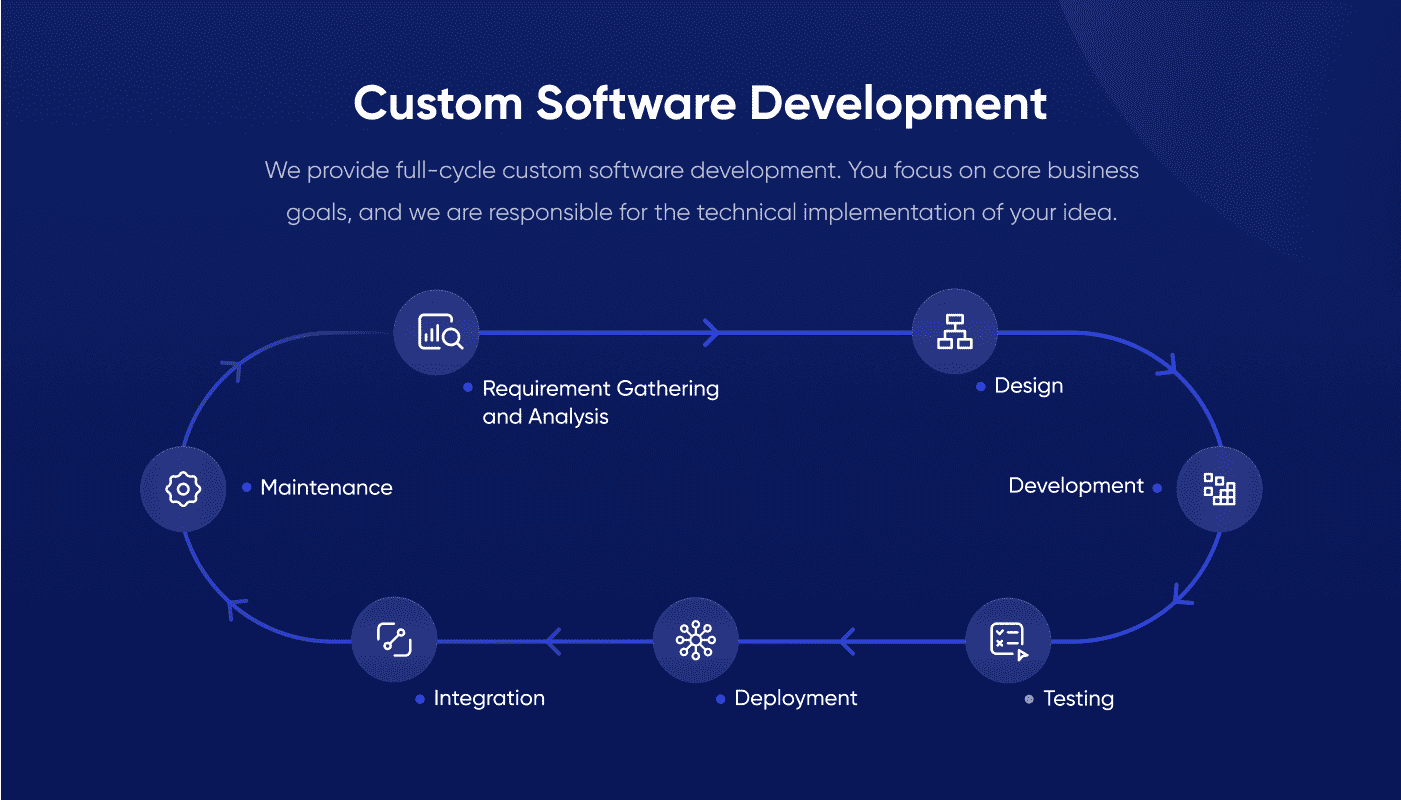

It is crucial that you initially build a product development cycle. That is, you should not only determine the starting and ending points of development but also take into account that the process of creating a product always goes in a circle.
The processes are repeated until the product starts to function as you and your users want. Usually, the product development cycle includes:
- Idea generation
- Idea screening
- Concept development and testing
- Market strategy/Business analysis
- Product development
- Market testing
- Market entry/commercialization
Always try to improve your project, namely, make it more usable, sound, and diverse.
Read Also: How to Build a Fintech Mobile App in 2023? The Guide from Top-Rated Team
What do You Need to Check Before Create a Cryptocurrency Exchange?
Now let’s discuss the things that you definitely need to check so you will know how to create a cryptocurrency exchange.
1. Monetization Strategy
If you want to make money from your business (and we are sure you do), you need to think about a monetization strategy. There are many options. For example, you can charge some % of the operations carried out in your exchanger. Thus, with each new operation made by users, you will receive money.
Or, for example, you can make different types of accounts with different privileges. Those users who want to switch from a regular account to a more advanced one, for example, will have to pay a certain amount per month.
2. Legal Restrictions
Here are some legal aspects to remember when developing a crypto exchange:
- GDPR compliance. If you develop a product for the EU market, you should ensure that your crypto exchange is GDPR compliant. GDPR, or General Data Protection Regulation, went into force on May 25, 2018. If you don’t want to get fined, you can’t disregard or skip this step.
- CCPA compliance. The California Consumer Privacy Act (CCPA) is the law you must follow if you develop products for California citizens. This law’s major purpose is to give people more control over their personal data. If California is your target market, you must make your crypto exchange platform CCPA-compliant beginning January 1, 2020.
- Remember that local rules and regulations may differ; everything depends on the place you intend to create a platform. So, whether Asia, the United Kingdom, Australia, or other locations are your target markets, pay attention to each region’s local rules.
3. Write Typical Agreements and Policies
Prepare all necessary agreements and policies in advance. Without this, users will not be able to get started with your platform. It’s best to do all this before you start designing and developing the product, so you don’t waste time on it later.
4. Your Own Market Trends Overview
Your biggest advantage will be showing users of your platform your own market analytics. Of course, they can read all the news and trends on the Internet, but it is almost impossible to find high-quality and personalized analytics.
5. Cross-Platforms Product
Today, most modern users choose products that they can use on their phones, PCs, and tablets. Therefore, we recommend that you consider in advance what kind of platform you want to create. If you want your product to be available to people with different preferences, make a universal exchanger that will work on all devices.
The Must-Have Features for Your Crypto Exchange in 2024
How do you create a cryptocurrency exchange that will be in demand? That’s right – fill it with the necessary functionality. We have compiled a list of must-have features for your crypto exchange in 2022. Let’s look at them in detail:
Personal account
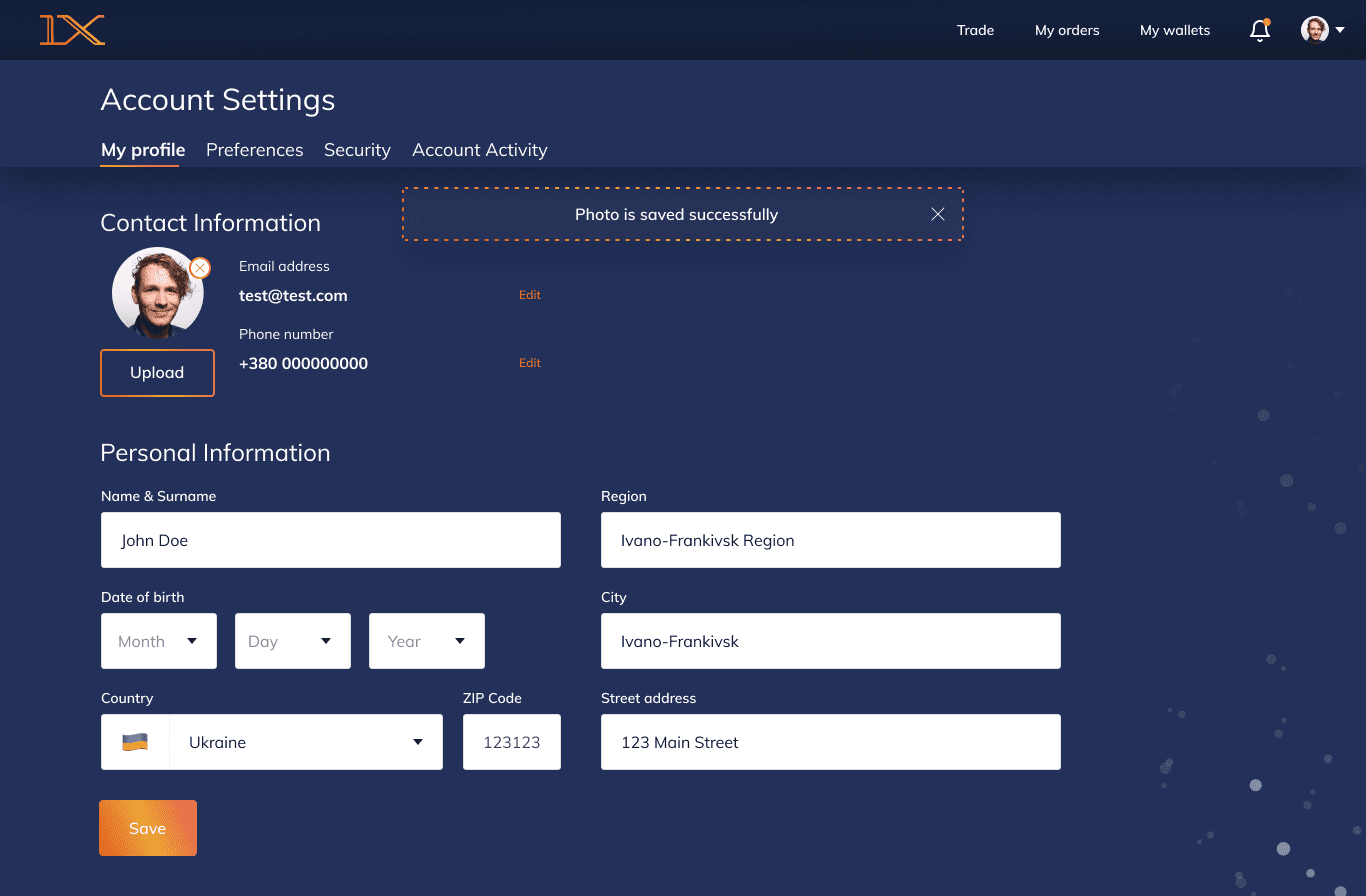

RewiSoft Case – Exchange Platform Development
A personal account is the basis of a crypto exchange. There, users store all personal information and, in fact, start working with the platform from it. Don’t make your account too complicated to navigate. A personal account should contain only the most essential elements that will help users perform the necessary actions quickly and effortlessly.
Onboarding on the platform
Onboarding is necessary for users to quickly understand how to use the platform, where the platform sections they need are located, and how to achieve their goals. It is an essential element for improving the quality of the user experience.
Basic security settings
Since your crypto exchange will contain a lot of users’ personal information, their money, and their cryptocurrency, it is essential to make the platform secure. You will need to provide your platform with a security system that can prevent the leakage of data and money.
Crypto-wallet
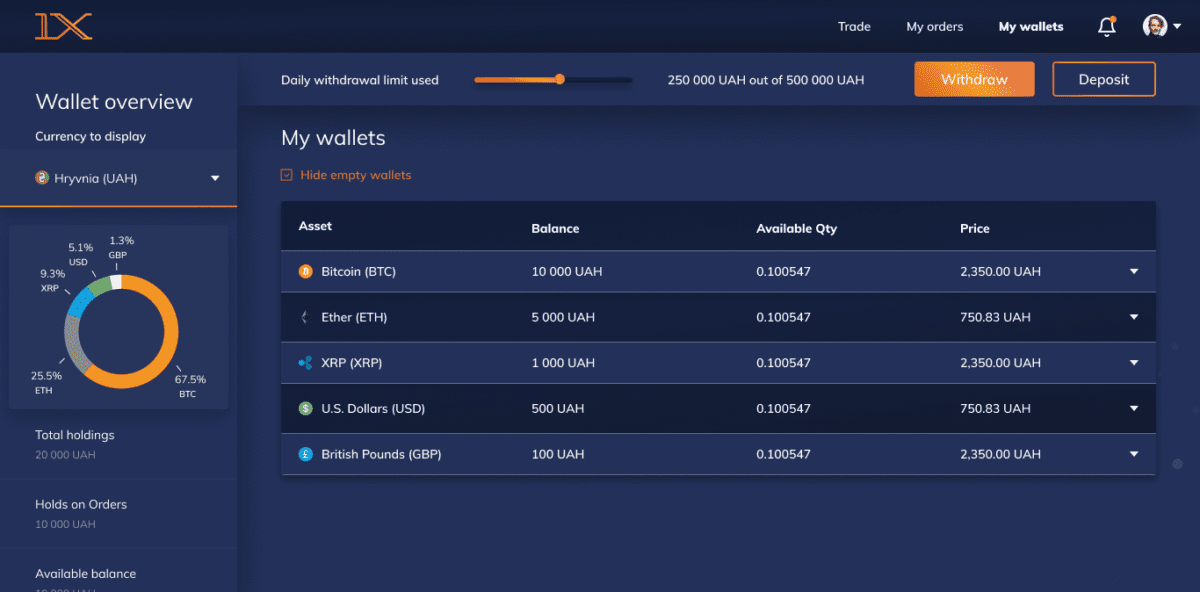

RewiSoft Case – Exchange Platform Development
For users to be able to operate with their cryptocurrency, they need to store this cryptocurrency somewhere. Therefore, you will need to add a crypto wallet, where users can not only store cryptocurrency but also sort it.
Notification
Add a notifications feature so that users do not miss important news on the platform. Also, add the ability to turn off notifications. But usually, on such platforms, users, on the contrary, actively use this function to follow, for example, the current bitcoin exchange rate.
Chatbot support
This feature is needed so that users have quick and easy access to support. With chatbot support, users can quickly solve any urgent questions or difficulties.
Integration with bank cards
For users to be able to exchange money for cryptocurrencies, the platform should be able to connect bank cards. Without this feature, the work of the platform is impossible.
History of transactions and interactions
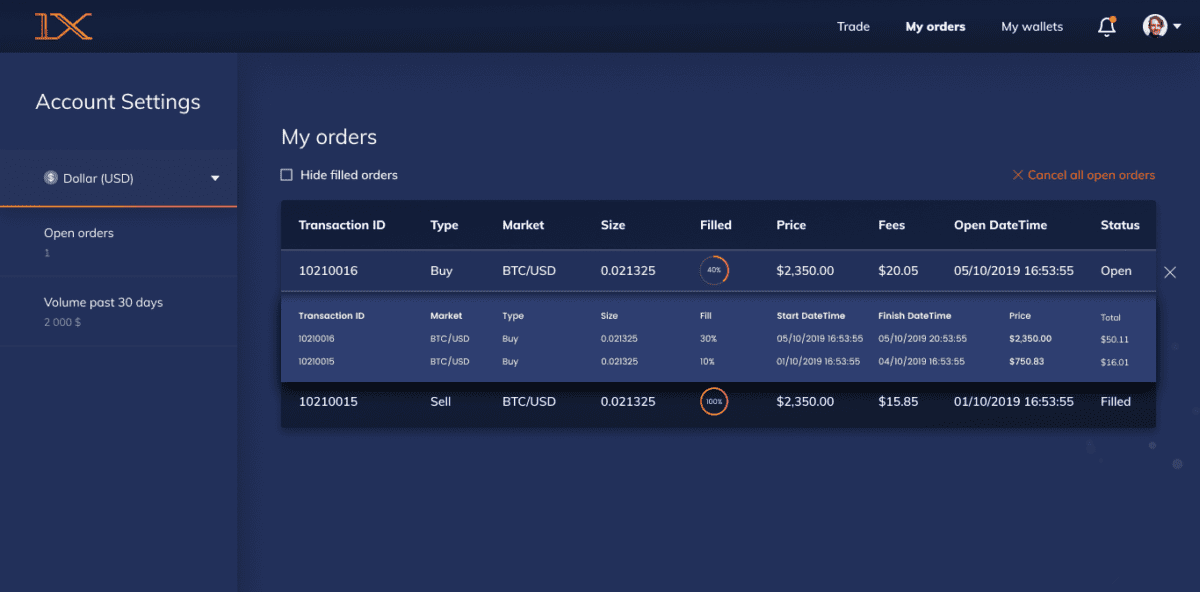

RewiSoft Case – Exchange Platform Development
Add a history of transactions and interactions to your crypto exchange platform so that users can control the movement of their money and cryptocurrencies.
Rating and feedback system
This feature is more needed for you as the owner of a crypto exchange. Users using this feature will be able to rate the platform and leave feedback. This system will help you understand what needs to be improved.
Trading engine system
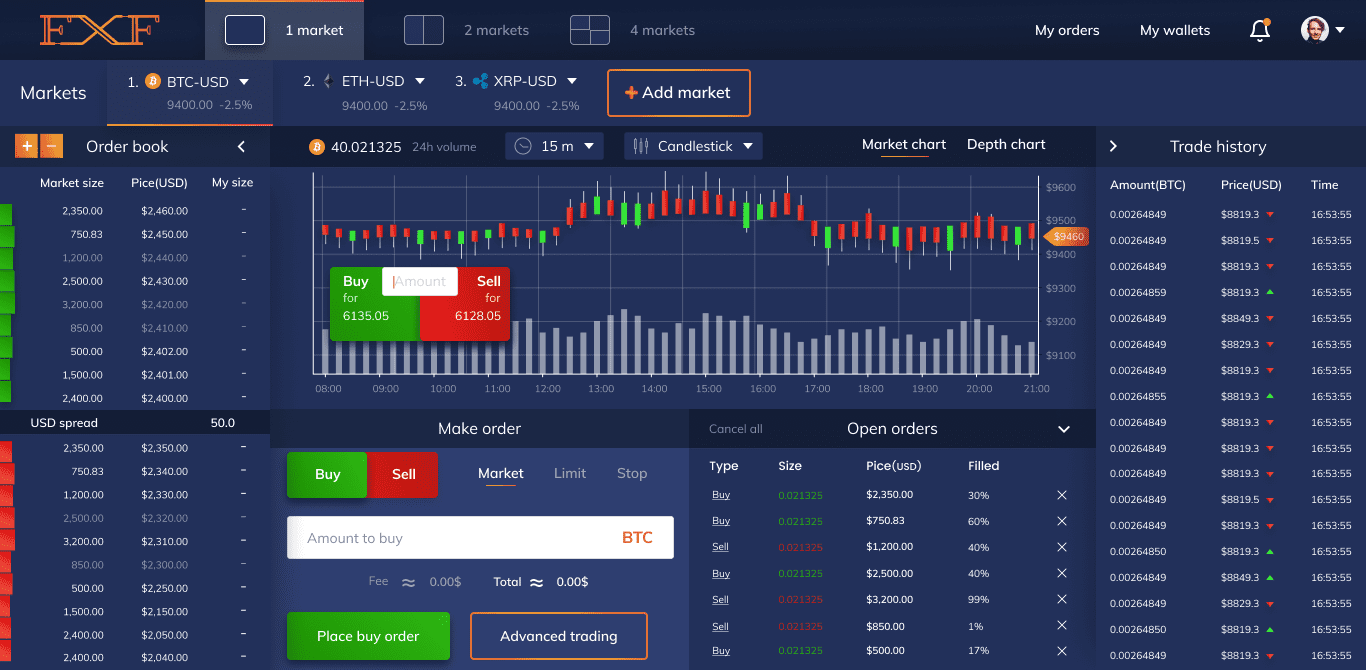

RewiSoft Case – Exchange Platform Development
Your crypto exchange’s trading engine is its heart and soul. That is where all trading logic is stored. This feature would typically involve an order-matching engine that compares sellers’ requests to purchasers’ bids.
Dashboard with current operations
A dashboard is the most convenient place to put all the critical information about the recent users’ operations, especially if you make it in the form of various charts and tables.
Filters and configurations
Let your users customize the search or the platform itself to suit their needs.
Referral program
This feature is now very popular among various FinTech products. It allows users to receive certain bonuses for, for example, inviting their friends to use the platform.
The Advanced Features for Your Crypto Exchange in 2024
If you want your crypto exchange platform to be more high-level, then we suggest you explore the advanced features that you can add to your platform:
Cold crypto-wallet
Cold crypto wallets can work offline. They only require connection to the network when the user needs to make an operation to withdraw cryptocurrency.
The use of biometric data
To identify the user on the platform, you can use biometrics – for example, scanners of the iris, facial geometry, or a fingerprint. The use of such technologies is now very popular.
AML/KYC/KYT
We wrote about these things in more detail above. This functionality will help make your platform more secure.
Arbitration
Intra-exchange arbitrage of cryptocurrency rates is a comparison of the rates of various crypto coins within an exchanger to exchange cheap cryptocurrencies for expensive ones and make a profit. This feature is now at the peak of popularity!
NFT Integration
NFTs (non-fungible tokens) are non-fungible tokens that represent ownership titles to various digital objects: texts, images, audio recordings, digital works of art, game items or characters, domain names, financial instruments, club cards, etc.
Each NFT is unique and exists in a single copy, it cannot be divided, and all information about its author, buyer, and transactions is securely stored in the blockchain. In other words, an NFT is a digital certificate attached to a unique object.
Therefore, by adding the ability to integrate your platform with NFT, you open up even more opportunities for users to exchange.
Your own token
One of the most advanced features of crypto exchanges today is the creation of your own token. This feature allows you to create your own digital coin and further develop your project. Tokens are often used as transactional coins for exchange, which saves money.
Training programs and AI system recommendations
This feature will help users learn how to correctly exchange currency on the platform. But that’s not all. Thanks to AI, the system will be able to analyze the possible exchange options for users and recommend the most profitable options for them.
What Tech Stack Do You Need to Develop Crypto Exchange?
Now let’s talk about which tech stack is better to choose for creating a crypto exchange for different devices.
For Mobile App Development
IOS
Here is what we recommend to use for crypto exchange creation for the IOS system:
Language: Objective-C, Swift.
Core: iOS SDK, CocoaTouch / Multimedia.
Analytics: Firebase, Amplitude, AppsFlyer, Facebook.
Data: Realm, CoreData, UserDefaults, KeyChain, CryptoSwift.
Android
For the Android system, we advise your team to use the following for cryptocurrency exchange architecture:
Language: Java, Kotlin.
Core: Android SDK, Android Jetpack.
Analytics: Firebase, Amplitude, AppsFlyer, Facebook.
Data: Realm, SQLite, Shared Preferences, Room.
For Web App Development
If you are planning to develop a web crypto exchange, then we recommend using the following tech stacks:
- Vue.js
- Angular
- React.js
- PHP
- Django
- Laravel
For Blockchain Development
In the case of blockchain development, everything depends on what coins and platforms you will have to work with. If you want to know more specifically, you can contact us.
A Few Words About Crypto Exchange Architecture
What components are required to construct your own crypto exchange?
- Trading engine
It is a place where all trading logic is stored. This block would typically include an order-matching engine that compares sellers’ requests to buyers’ bids.
- Multi-cryptocurrency wallet generator
Remember that every client gets a wallet. You’ll need a way to accomplish it automatically. In reality, each client receives numerous wallets (for various coins) that work in tandem with your internal wallets to ensure the most efficient money transfer.
- Admin dashboard
An admin panel is a location for your platform’s operators to control the platform. It is often role-based and secured with hardware security keys.
- Server of authentication
A server for verifying and certifying your clients’ identities.
- API layer
APIs are used to link building blocks. They also help in the integration of your exchange with third-party solutions. There are several things to connect to, including liquidity providers, payment gateways, multiple blockchain explorers, trading bots, analytics, logging, and so on.
How to Create Crypto Exchange? [All Development Process]
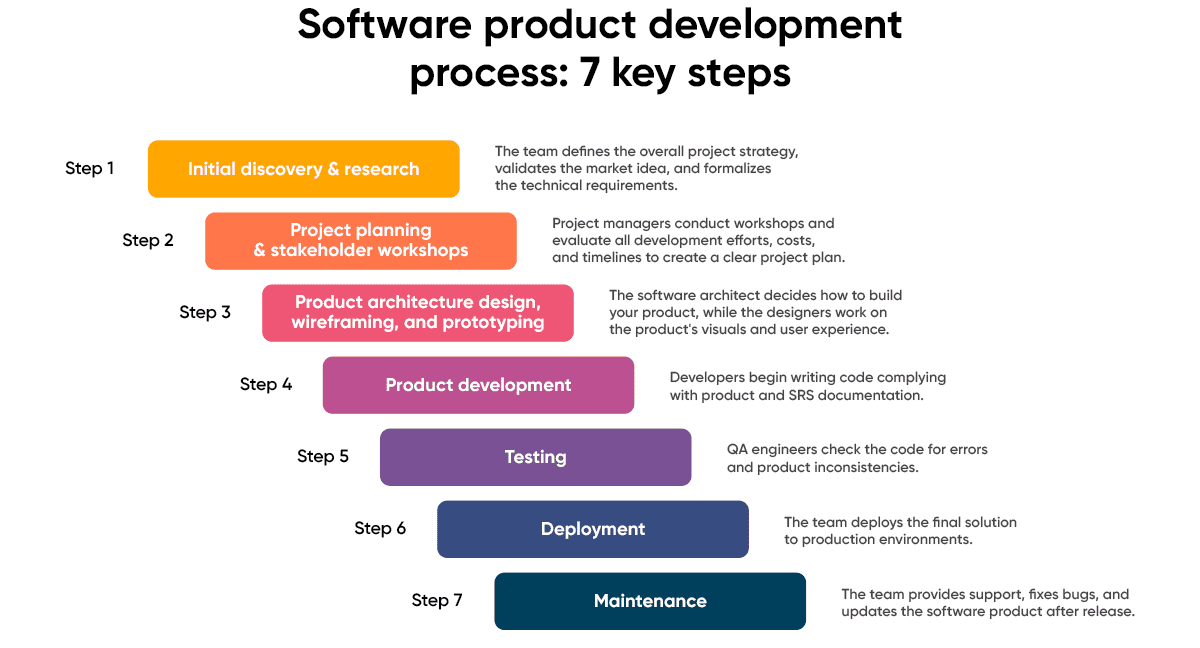

How to Create Crypto Exchange: 7 key steps
Now let’s move on to the most interesting part and discuss how to build a cryptocurrency exchange.
Point 1: Develop and Describe Your Idea
As we said earlier, you need to be clear about what you want to develop. Therefore, describing your idea at the first stages of creating a product is very important. The more details you include, the better for you and your future team.
Point 2: Legalities Questions and Project Registration
Next, you need to register your project at the legal level. Your product must fully comply with the rules and laws followed in your country. Take this step very seriously. One mistake can cost you dearly.
Point 3: Marketing Research and Product Discovery
When we work on projects, we usually get involved at this stage. At this step, it is necessary to conduct marketing analysis, namely, an analysis of the market, competitors, and existing products.
It is also necessary to conduct a product discovery. Product discovery aims to find a product/market fit and validate the business model with a working version of the product. The key to achieving this is to consistently reduce risks by validating customer behavior hypotheses, value propositions, product solutions, business models, and acquisition channels.
Point 4: UX Design: Content hierarchy, navigation and logic
The UX design of a crypto exchange is the process of creating a product that provides users with a meaningful and relevant experience. It involves researching and analyzing all information related to customers, organizing content, and arranging it so that the user can quickly and easily find what they are looking for.
The goal of UX design is to create a digital product that the user will feel comfortable with. This includes how the product functions and the user manages it: content hierarchy, clear navigation, and the functionality of visual elements. But the most important thing is that all this helps solve the user’s problem.
In addition, the design should be created in accordance with technical and business specifications. Here are the steps that the UX design process usually consists of:
1. Product definition
- Stakeholder interviews
- Value proposition mapping
- Concept sketching
2. Research
- Individual in-depth interviews
- Competitive research
3. Analysis
- Creating user personas
- Creating user stories
- Storyboarding
4. Design
- Sketching
- Creating wireframes
- Creating prototypes
- Creating a design specification
- Creating design systems
5. Validation
- Testing sessions
- Surveys
- Analytics
Here is how we implemented the UX design for our partner FXF:
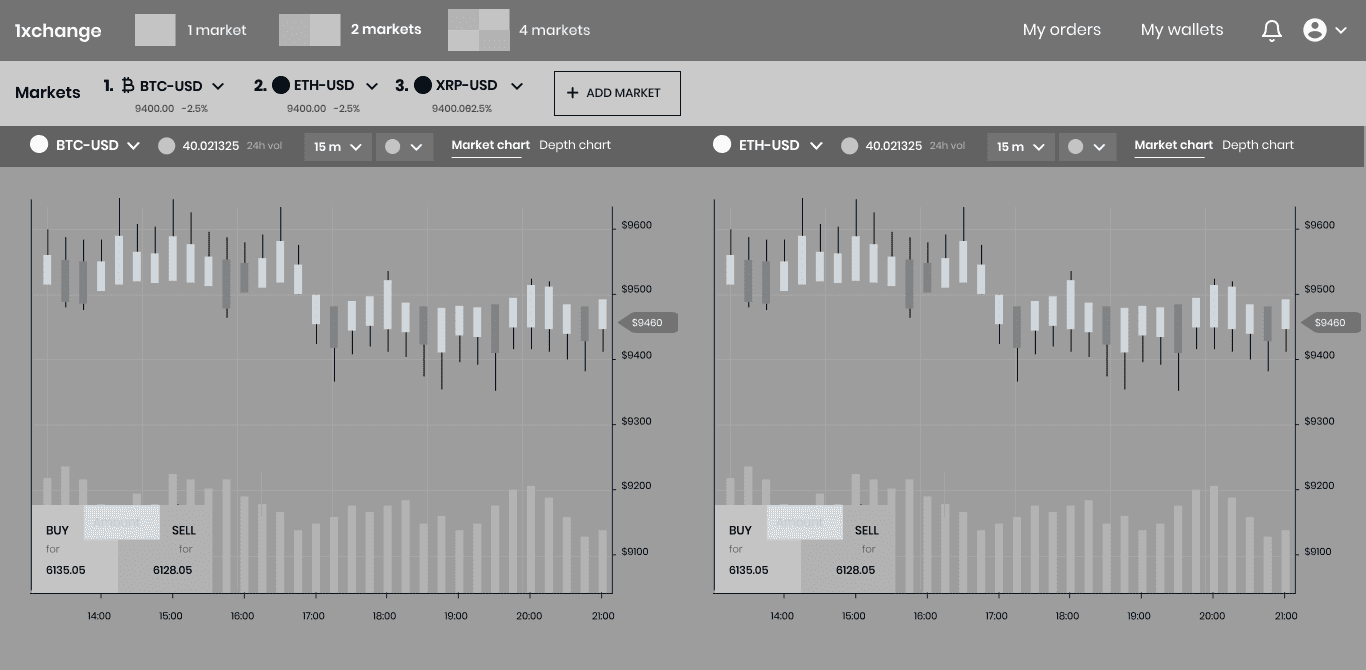

RewiSoft Case Study – FXF
Point 5: Product Testing
After the UX design is ready, you will need to test it. At this stage, you should understand whether you have built the product logic correctly, whether it is clear to users where everything is located in the product, whether everything suits them, etc.
After receiving the test results, you will know whether you need to change something in the UX design or not.
At RewiSoft, we use our in-house UX Laboratory, which analyzes how people interact with the interface and uncover products’ usability gaps.
To know more about our UX Lab…
Point 6: UI Design: UI guideline and visual elements
UI design is the process of visualizing a prototype that was developed based on user experience and target audience research. UI design includes work on the graphic part of the interface: animation, illustrations, buttons, menus, sliders, photos, and fonts.
UI design is responsible for how the product interface looks and how the user interacts with its elements. It is necessary to correctly organize the interface elements and maintain a single style and logic of their interaction. Your main task is to help the user understand how to use the product quickly and without stress. To do this, you should ensure that the interface meets the basic requirements.
Point 7: Start Crypto Exchange Development Life Cycle
Now you need to translate the design into a working product. We divided the entire development life cycle process into several steps. Let’s take a closer look at each of them.
Point 7.1: Product Technical Documentation
During this stage, all the relevant information from the client is collected to develop a product as per expectations and requirements. The team should write technical documentation and choose technical stacks.
At this stage, the team should also define the requirements for functionality (requirements for the admin panel) and user roles (admin and super admin). The team should complete the estimate and scope of work.
Point 7.2: Crypto exchange Front-End Development
Developers use the documentation and architecture from previous steps to write code for all the platform components. The main tech stacks to use during crypto exchange front-end development are Angular, Vue.js, and React.js.
Point 7.3: Crypto exchange Back-End Development
Server-side development is another name for back-end development.
It is everything that users do not see and includes all of the actions behind the scenes when they perform any operation on a platform. It largely focuses on databases, backend logic, APIs, and servers. Here the main tech stack to use during crypto exchange back-end development is Node.js.
Point 7.4: Blockchain Development Part
At this stage, blockchain developers are actively working on creating a blockchain network or a decentralized application for that network. Blockchain development includes:
- designing blockchain networks, consensus protocols and decentralized applications;
- developing, testing, monitoring and maintaining a blockchain network, with a focus on performance, distributed computing, consensus protocols, cryptography and other security measures;
- developing, testing, monitoring and maintaining decentralized applications, smart contracts, back-end systems, client-side applications and any other components that make up the application stack.
Point 7.5: QA
QA engineers test all delivered code and carry out manual testing for developed components. Thehe main QA aspects to use are CI/CD, integrational, automation strategy, regression, and resource planning.
Point 7.6: Deployment & Integration
After the development and regression testing from the QA team, the team switches to production deployment and integration. The tested version of the product is delivered to the users for beta testing. The team collects user feedback, fixes all the bugs, and implements some improvements.
Point 7.7: Maintenance
After deploying a product in the production environment, the development teams keeps up with maintenance of the product. The team will fix any issues that come up and update the platform as needed.
Point 8: Obtaining and analyzing user feedback
Next, collect user feedback about your crypto exchange site. Take a survey to get answers to the following questions:
- Is it convenient to use your platform?
- Do users encounter any problems while using the product?
- To what extent does a robust trading platform cover the needs of users?
- What would users like to improve in the product?
- How does the product meet user expectations?
By getting answers to these questions, you will know what you need to change, remove or add to the product.
Point 9: Improve and develop
The creation of the product does not end there. After analyzing user feedback on your product, you should continue to improve and develop it. Remember – progress is the key to success!
How Can RewiSoft Help You?
The RewiSoft team has a wealth of experience in creating cryptocurrency exchanges. We provide our partners with the following:
- Full-cycle development (UX/UI, back-end/front-end)
- Back-office management
- Security and compliance
- Data collection & handling
One of our partners, FXF, is a cryptocurrency application that aggregates offers from participating exchanges, thus providing users with access to the best buy and sell prices.
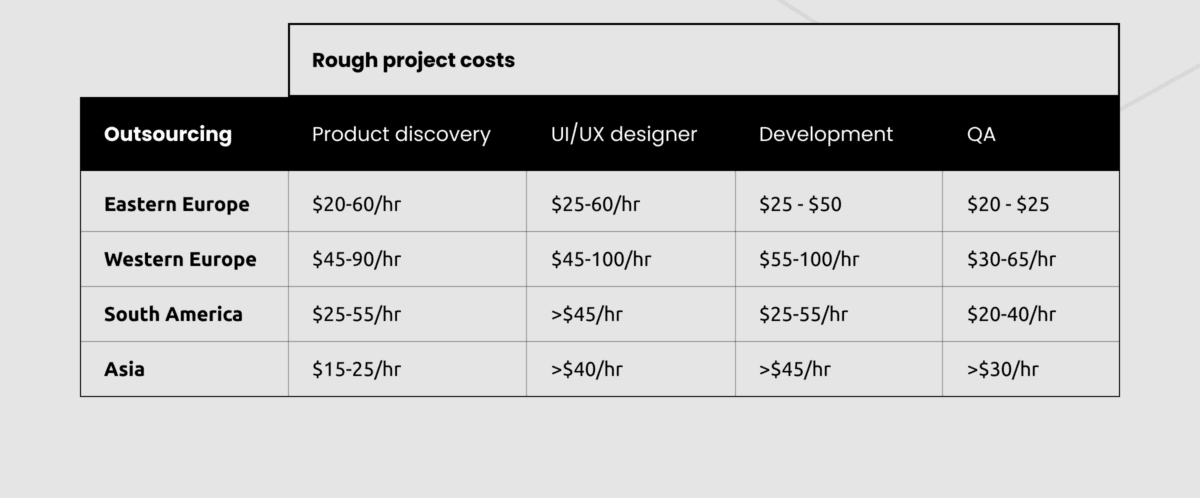

Let’s also consider how long it takes to create a crypto exchange website. For your convenience, we calculated how much time each stage of crypto exchange website development will take for different sizes of businesses:


Having this information in mind, you can calculate the approximate development cost and timeline of the entire project.
Create a Crypto Exchange Platform: Final thoughts
Cryptocurrencies are more popular than ever. The market is still young and has a lot of places for new, innovative ideas. RewiSoft believes that there are numerous opportunities for success in the market.
Have any questions concerning cryptocurrency exchange?







